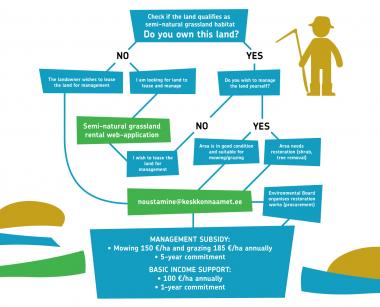A meadow with natural vegetation is called a semi-natural habitat and its inherited from our ancestors. The appearance and values of these areas have developed and been preserved through long-term sustainable, nature-friendly management. Thus, human activity plays an important role in the formation and survival of semi-natural habitats alongside natural conditions.
At the beginning of the twentieth century, semi-natural habitats were estimated to have covered up to 40% of Estonia’s territory, or 1.8 million hectares. Due to a change in land use, this area has decreased and there are currently about 80,000 hectares of meadows (including 60,000 hectares in protected areas), with only 40,000 hectares being managed each year. As meadows form the core area of Estonian biodiversity, their management is very important.
The landowner often has to decide on the future of the meadow. The best option is to follow the example of our ancestors and continue regular maintenance by mowing or grazing the area annually. To support the land managers in their decisions and actions on meadows the project provides together the Environmental Board advice to those landowners who are ready to manage or lease their meadows.
A consulting service has been set up in the Environmental Board will help to find a suitable solution for a specific meadow. Together with the landowner, advisors perform an on-site inspection of the meadow, discuss possible solutions and introduce the best practices and support measures for the restoration and management of the heritage meadow.
We are keeping track of whether this approach increases the involvement of landowners, thereby helping to restore and manage heritage meadows more efficiently than before.
The landowner can find relevant information on where to start, how to restore and maintain their heritage meadows, and what support schemes are available in the advice section (in Estonian).
The Action Plan (2021-2027) for Semi-Natural Grasslands is available here.
